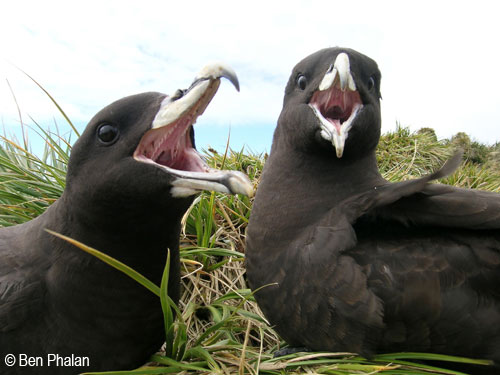Clara Péron of the Centre d'Etudes Biologiques de Chizé in France, along with British, French and German colleagues, has studied the at-sea distribution of White-chinned Petrels Procellaria aequinoctialis that breed at the French Kerguelen Islands in the southern Indian Ocean. Their findings have been published recently in the journal Marine Ecology Progress Series.
The paper's abstract follows:
"Marine environments experience seasonal variation in physical and biological parameters, with consequent changes in predator distributions. During the breeding period, proximity to suitable feeding sites is essential for central place foragers, whereas during the non-breeding period their distribution is relatively unconstrained. We combined light-based geolocation and satellite tracking to investigate seasonal variation in foraging grounds and behaviour of White-chinned Petrels from Kerguelen Island. Birds were associated with highly productive areas throughout the year. During breeding (summer), they performed long commuting trips from the colony to distant, productive Antarctic waters. Thereafter, birds migrated 5200 km westwards to the Benguela upwelling system off Namibia and South Africa to spend the winter. This seasonal shift of foraging grounds coincides with a change in activity patterns; much less time was spent in flight in winter than in summer. Individual variability in the locations of foraging zones and seasonal/daily activity patterns was low. Trip durations were shorter during chick-rearing than incubation, although birds often travelled as far or farther, tracking the gradual break up of pack ice. Habitat use models revealed an association with distance to sea-ice edge and chlorophyll a gradient during incubation, whereas sea surface temperature and chlorophyll a gradient best explained habitat use during chick rearing. White-chinned petrels are likely to overlap with other marine predators and fisheries throughout the year. Fishery bycatch constitutes the most significant direct threat to petrels at sea. Moreover, future climate-induced reductions in productivity could affect birds year-round."

Reference:
Clara Péron, Karine Delord, Richard A. Phillips, Yohan Charbonnier, Cédric Marteau, Maité Louzao & Henri Weimerskirch 2010. Seasonal variation in oceanographic habitat and behaviour of White-chinned Petrels Procellaria aequinoctialis from Kerguelen Island. Marine Ecology Progress Series 416: 267-284. http://www.int-res.com/abstracts/meps/v416/p267-284/.
John Cooper. ACAP Information Officer, 16 October 2010

 Français
Français  English
English  Español
Español